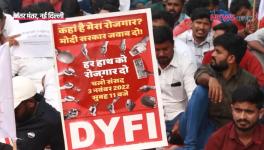Argentina: Upsurge of Neo-Fascism and ‘Dollarisation’

Javier Milei. Image Courtesy: Flickr
Argentina’s new president Javier Milei proposes to use US dollars as the currency of his country, while abolishing its central bank altogether.
What is involved in this proposal is not just maintaining a fixed exchange rate between the dollar and the domestic currency, but an abolition of the domestic currency altogether.
The maintenance of a fixed exchange rate does not preclude the central bank of the country printing more of the domestic currency whenever there is a demand for more domestic currency, while using an array of instruments to ensure that there is no shift to dollars from the domestic currency so that its exchange rate remains fixed. But “dollarisation” means a complete shift to dollars by abolishing both the domestic currency and the central bank that is normally entrusted with the responsibility of printing it.
An example will make the difference clear. Suppose at the given level of the gross domestic product (GDP), of prices and the interest rate, the total demand for money happens to be 100 units of domestic currency, while its supply is 90; then the central bank can print 10 units of additional domestic currency with impunity, without any fear of this additional printing upsetting the fixed exchange rate vis-à-vis the dollar.
But in the case of a “dollarised” economy where the dollar alone is the currency used, if the demand for dollars at the given level of GDP, of prices and the interest rate, happens to exceed the supply of dollars in the economy, then there is no question of printing any additional dollars since that can only be done by the US central bank and not by the central bank of the country in question, which in any case has been abolished altogether.
In such a case, the only options available to the country are: either obtain dollars by whatever possible means (by borrowing from abroad or selling the country’s assets if necessary) to maintain the level of GDP; or curtail the GDP until the demand for dollars falls to equal the supply of it; or some combination of the two. The option of obtaining a larger supply of the currency by simply using the central bank is ruled out.
A country’s external indebtedness, in other words, goes up (or its material wealth goes down by being sold to foreigners), not just because it spends more than its income (as is often the case under normal circumstances and expressed in a current account deficit on the balance of payments), but also because its demand for the circulating medium increases relative to the supply for it.
This entails a doubling of the contractionary squeeze on the economy if the level of external debt is not to increase. Suppose, to start with, the economy is in equilibrium, and then its exports rise in a particular period by $10; if its imports are 10% of GDP then (ignoring other current account items), its GDP can rise only by $100 without requiring any increase in its external debt.
This is the first contractionary squeeze on the economy, namely the curtailment of the increase in its GDP so as to balance its external account. But, if the ratio of currency (or what is called reserve money) to GDP also happens to be 10% for the purpose of circulating the GDP, then for sustaining an increase of $100 of GDP, an additional $10 would be required. Since these $10 dollars be domestically printed, an increase of $100 in GDP cannot be sustained, if external indebtedness is not to increase.
The increase in GDP in this case can only be $50, for only then will the additional demand for $5 for imports and $5 for circulating GDP, equal the amount of dollars earned through exports. This is the second squeeze on GDP, arising from the need for the circulating medium.
The country’s dollar earnings, in other words, will now have to pay both for its imports and for its requirement of the medium of circulation.
By abolishing the domestic currency altogether, and hence the possibility of a central bank printing this domestic currency to provide for the requisite supply of the medium of circulation, and adopting instead the currency of a foreign country as its medium of circulation when that foreign country’s central bank is under no obligation to print currency to satisfy our requirement for an increased amount of the medium of circulation, we introduce an additional constraint on a country’s GDP, which would now have to be doubly squeezed.
This double squeeze would have to be effected through cuts in welfare expenditure, cuts in salaries of government officials, cuts in pensions, cuts in wages of workers, and, of course, cuts in employment.
In other words, the adoption of the dollar as the country’s currency when these dollars are printed abroad, with the country having no control over their supply, except to the extent that it earns them through exports alone (if its external indebtedness is not to increase or domestic assets are not to be sold to foreigners), necessarily means greatly intensified misery for its population.
And if these modes of assault on the population are not employed immediately because dollars are borrowed from abroad, then that only postpones the assault; it does not prevent the assault.
Why then does a government resort to such an absurd step of replacing its own domestic currency by the US dollar? The ostensible reason in Argentina’s case is the extremely high rate of inflation, running at around 150% per annum. Since, under capitalism, the only antidote to inflation (whether this is explicitly admitted or not) is the creation of unemployment and the effecting of a wage cut, Javier Milei is resorting to this antidote with a vengeance. But the chicanery behind this needs to be exposed.
The previous Right-wing president Mauricio Macri had taken a large external loan to manage Argentina’s balance of payments deficit, much of which was used to finance private capital flight from that country. When the time came to start paying back that loan, the balance of payments was seriously strained. And this strain was also accentuated by the flight of capital undertaken by the Argentine rich. The depreciation of the currency that ensued caused a cost-push inflation owing to the rise in the local currency costs of imported inputs which got passed on to final goods prices.
Now, in a society where wages are indexed to prices, and workers are generally organised into strong trade unions, even a slight nudge to inflation quickly causes a sharp rise in prices, owing to the absence of the sort of “cushion” that a vast army of unorganised workers provides. It is not surprising, therefore, that inflation in Argentina became so rapid within a short time.
The Milei government proposes to control this inflation not by introducing curbs on capital flight, not by stabilising the exchange rate through introducing appropriate trade controls to overcome the foreign exchange shortage, not by implementing any direct price control, but by launching a massive attack on the Argentine working class and its trade unions.
In other words, Milei’s policy proposal amounts to a most vicious form of class attack on the working class of that country. The working class is made to bear the burden of the repatriation of wealth by Argentina’s rich from that country to the metropolitan centres.
Javier Milei is the latest addition to the list of neo-fascist rulers that are coming up in various parts of the world. This upsurge of neo-fascism is a reflection of the crisis of neo-liberalism, in the context of which the big bourgeoisie is entering into an alliance with fascist elements to maintain its hegemony and to attack the working class.
The neo-fascist rulers that are coming up in the present conjuncture, however, can only change the form of the crisis, from, say, inflation to the imposition of unemployment and income compression on the workers, as is being proposed in Argentina, but cannot resolve the crisis.
In fact, as the crisis intensifies and the rate of growth of exports slows down even further for countries like Argentina, the Argentine neo-fascist strategy will greatly increase the burden on the workers in the form of unemployment and income compression.
The double contractionary squeeze referred to above will become even more suffocating for the people. What is needed is a resolution of the crisis by transcending the neo-liberal regime itself.
Get the latest reports & analysis with people's perspective on Protests, movements & deep analytical videos, discussions of the current affairs in your Telegram app. Subscribe to NewsClick's Telegram channel & get Real-Time updates on stories, as they get published on our website.
























